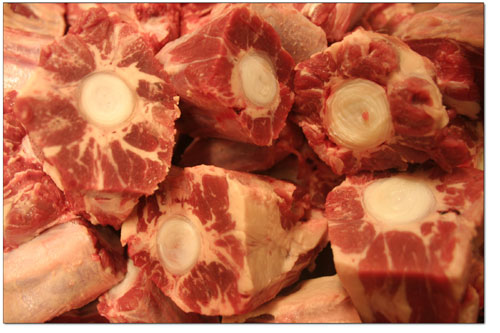| ||
Let there be grease
by Chef Boy Ari A large pig hangs behind the dining room bar. Drawn with simple lines, it looks like Wilbur from "Charlotte’s Web." “It’s Pig the pig,” says Paul Myers, not one to anthropomorphize such a load-bearing pillar of his universe. Myers, who has cooked alongside some of the most respected chefs in the nation – including Tom Douglas of Dahlia Lounge in Seattle, and Wylie Dufresene of New York’s WD50 – has developed his own personal feel for the triglyceride molecules we normally know as fat. Myers is a man committed to the art of decadence. One of his dishes features a 6-ounce rectangle of that which is normally sliced into bacon. After marinating for several days in a cocktail that Myers calls an “ancient Chinese secret,” the pork belly is braised for hours. In prepping the pork belly portions, random scraps are generated. These are deep-fried into rillons, which are served with mustard fruits and sweet and sour purple cabbage. While pig belly is widely considered one of the finer cuts of meat to exist anywhere, Myers has a big soft spot for underappreciated animal parts as well. “These recipes are old-world, utilization-based, from a time when none of the animal got wasted,” explains Myers, who can’t wait to get freaky on his menu with all kinds of off-cuts and offal. “It’s easier to start people off with pork belly and oxtail than, say, lamb kidneys and veal sweetbreads. But once my audience begins to trust me, I’ll get more adventurous.” Myers’ classic culinary training brings bits of European culture into his kitchen. Every time I visit Myers I learn new words. For example, miseenplace, French for “shit together” – as in “Hi Ari, c’mon in. I’m just getting my miseenplace.” That morning, getting his miseenplace meant chopping carrots, celery and onion, an important combination known as mirepoix. Though Myers can mince with the best of them, these cuts were large and chunky. “In larger pieces the vegetables won’t break down in the braise,” he explained. “In a stock, you can just cut carrots in half.” From a box on the counter Myers removed several large items that looked like soft-shelled armadillos, fat and roundish at one end and tapering off to a tail. The whole thing, it turns out – even the wide part – is a cow’s tail, built like a spine but with no spinal cord. Myers trimmed the layers of fat covering the meat. Then, his knife found the space between each vertebra, separating the tail into disks. The oxtails went into sauté pans, sizzling with grapeseed oil on the stovetop. The oxtails sputtered their way to a brown crisp. Hot oil was flying everywhere. Meyers calmly navigated the pans, which would ignite from time to time into rather large fireballs. In that moment he was Beethoven with a spatula. He calls activities such as this “creating grease.” If you’re following along at home and not making 60 servings of oxtail, you won’t create nearly this much grease. And while Myers had neither time nor need to use lids on his pans to contain the splatter, you do. The browned oxtails were transferred to an oven pan, and the mirepoix chunks went into the sputtering sauté pans to be drenched under generous pours of red wine. As if all this weren’t enough, Myers then reached for the precious brown gelatin, his ace, a super-enriched stock known as demi-glace. Prepared the day before from roasted veal bones coaxed into stock with the help of mirepoix, a bouquet garni and other goodies, it was cooked very slowly, filtered, skimmed of fat and combined with Myers’ version of sauce espagnole. After adding scoops of demi-glace to the bubbling pans, he reduced the liquid by half. Then he dumped the pans’ contents over the browned oxtails, tossed them with fresh thyme and bay leaves, and added chicken stock, leftover braise from yesterday’s oxtail session and more wine. The oxtails, swimming in the pan, were covered and baked at 300 degrees for six hours, until the meat was ready to fall off the bone. The pan was then slowly cooled and kept in the fridge until serving time, at which point he “brings up the oxtail” in a pan, swimming in braise. You’re on your own from here. If you want to be like Myers, add chicken stock, veggie stock, more demi-glace and a ladle of finishing sauce to your sauté pan. When it’s hot, bed your oxtails on sautéed kale and truffle buckwheat polenta, whose fungal earthtones waft upward into the cartilaginous meat, which is sprinkled with a tangy fresh gremolata of lemon zest, parsley and horseradish. The oxtail’s connective tissues re-congeal quickly, causing your lips to stick to the wineglass, as if it were frozen. So sip quickly, lest your lips stick to the glass. And sip often, to clean your teeth lest they stick together when you’re trying to chew. •
|
In this week's issue...
- December 18, 2025
- Let it snow
Although ski areas across the West have taken a hit, there’s still hope
- December 18, 2025
- Look, but don't take
Lessons in pottery theft – and remorse – from SW Colorado
- December 11, 2025
- Big plans
Whole Foods, 270 apartments could be coming to Durango Mall parcel


